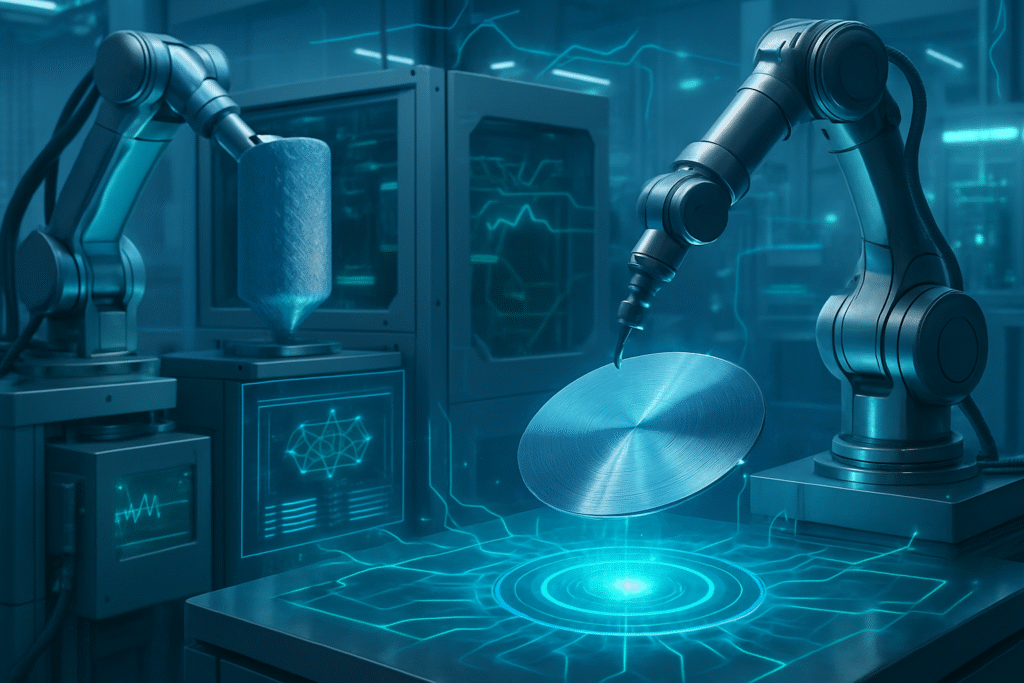CVD Equipment Soars as Strategic Order Ignites Silicon Carbide Market, Fueling AI’s Power Demands

Central Islip, NY – October 15, 2025 – CVD Equipment Corporation (NASDAQ: CVV) witnessed a significant surge in its stock price today, jumping 7.6% in premarket trading, following yesterday's announcement of a crucial order for its advanced semiconductor systems. The company secured a deal to supply two PVT150 Physical Vapor Transport Systems to Stony Brook University (SBU) for its newly established "onsemi Silicon Carbide Crystal Growth Center." This strategic move underscores the escalating global demand for high-performance, energy-efficient power semiconductors, particularly silicon carbide (SiC) and other wide band gap (WBG) materials, which are becoming indispensable for the foundational infrastructure of artificial intelligence and the accelerating electrification trend.
The order, placed by SBU with support from onsemi (NASDAQ: ON), signals a critical investment in research and development that directly impacts the future of AI hardware. As AI models grow in complexity and data centers consume ever-increasing amounts of power, the efficiency of underlying semiconductor components becomes paramount. Silicon carbide offers superior thermal management and power handling capabilities compared to traditional silicon, making it a cornerstone technology for advanced power electronics required by AI accelerators, electric vehicles, and renewable energy systems. This latest development from CVD Equipment not only boosts the company's market standing but also highlights the intense innovation driving the semiconductor manufacturing equipment sector to meet the insatiable appetite for AI-ready chips.
Unpacking the Technological Leap: Silicon Carbide's Rise in AI Infrastructure
The core of CVD Equipment's recent success lies in its PVT150 Physical Vapor Transport Systems, specialized machines designed for the intricate process of growing silicon carbide crystals. These systems are critical for creating the high-quality SiC boules that are then sliced into wafers, forming the basis of SiC power semiconductors. The collaboration with Stony Brook University's onsemi Silicon Carbide Crystal Growth Center emphasizes a forward-looking approach, aiming to advance the science of SiC crystal growth and explore other wide band gap materials. Initially, these PVT systems will be installed at CVD Equipment’s headquarters, allowing SBU students hands-on experience and accelerating research while the university’s dedicated facility is completed.
Silicon carbide distinguishes itself from conventional silicon by offering higher breakdown voltage, faster switching speeds, and superior thermal conductivity. These properties are not merely incremental improvements; they represent a step-change in efficiency and performance crucial for applications where power loss and heat generation are significant concerns. For AI, this translates into more efficient power delivery to GPUs and specialized AI accelerators, reducing operational costs and enabling denser computing environments. Unlike previous generations of power semiconductors, SiC can operate at higher temperatures and frequencies, making it ideal for the demanding environments of AI data centers, 5G infrastructure, and electric vehicle powertrains. The industry's positive reaction to CVD Equipment's order reflects a clear recognition of SiC's pivotal role, despite the company's current financial metrics showing operating challenges, analysts remain optimistic about the long-term growth trajectory in this specialized market. CVD Equipment is also actively developing 200 mm SiC crystal growth processes with its PVT200 systems, anticipating even greater demand from the high-power electronics industry.
Reshaping the AI Hardware Ecosystem: Beneficiaries and Competitive Dynamics
This significant order for CVD Equipment reverberates across the entire AI hardware ecosystem. Companies heavily invested in AI development and deployment stand to benefit immensely from the enhanced availability and performance of silicon carbide semiconductors. Chip designers like NVIDIA (NASDAQ: NVDA) and AMD (NASDAQ: AMD), whose GPUs and AI accelerators power the vast majority of AI workloads, will find more robust and efficient power delivery solutions for their next-generation products. This directly impacts the ability of tech giants such as Amazon (NASDAQ: AMZN), Microsoft (NASDAQ: MSFT), and Google (NASDAQ: GOOGL) to scale their cloud AI services with greater energy efficiency and reduced operational costs in their massive data centers.
The competitive landscape among semiconductor equipment manufacturers is also heating up. While CVD Equipment secures a niche in SiC crystal growth, larger players like Applied Materials (NASDAQ: AMAT) and Lam Research (NASDAQ: LRCX) are also investing heavily in advanced materials and deposition technologies. This order helps CVD Equipment solidify its position as a key enabler for SiC technology. For startups developing AI hardware or specialized power management solutions, the advancements in SiC manufacturing mean access to more powerful and compact components, potentially disrupting existing product lines that rely on less efficient silicon-based power electronics. The strategic advantage lies with companies that can leverage these advanced materials to deliver superior performance and energy efficiency, a critical differentiator in the increasingly competitive AI market.
Wider Significance: A Bellwether for AI's Foundational Shift
CVD Equipment's order is more than just a win for a single company; it serves as a powerful indicator of the broader trends shaping the semiconductor industry and, by extension, the future of AI. The escalating demand for advanced semiconductor devices in 5G infrastructure, the Internet of Things (IoT), and particularly artificial intelligence, is driving unprecedented growth in the manufacturing equipment sector. Silicon carbide and other wide band gap materials are at the forefront of this revolution, addressing the fundamental power and efficiency challenges that traditional silicon is increasingly unable to meet.
This development fits perfectly into the narrative of AI's relentless pursuit of computational power and energy efficiency. As AI models become larger and more complex, requiring immense computational resources, the underlying hardware must evolve in lockstep. SiC power semiconductors are a crucial part of this evolution, enabling the efficient power conversion and management necessary for high-performance computing clusters. The semiconductor CVD equipment market is projected to reach USD 24.07 billion by 2030, growing at a Compound Annual Growth Rate (CAGR) of 5.95% from 2025, underscoring the long-term significance of this sector. While potential concerns regarding future oversupply or geopolitical impacts on supply chains always loom, the current trajectory suggests a robust and sustained demand, reminiscent of previous semiconductor booms driven by personal computing and mobile revolutions, but now fueled by AI.
The Road Ahead: Scaling Innovation for AI's Future
Looking ahead, the momentum generated by orders like CVD Equipment's is expected to drive further innovation and expansion in the silicon carbide and wider semiconductor manufacturing equipment markets. Near-term developments will likely focus on scaling production capabilities for SiC wafers, improving crystal growth yields, and reducing manufacturing costs to make these advanced materials more accessible. The collaboration between industry and academia, as exemplified by the Stony Brook-onsemi partnership, will be vital for accelerating fundamental research and training the next generation of engineers.
Long-term, the applications of SiC and WBG materials are poised to expand beyond power electronics into areas like high-frequency communications and even quantum computing components, where their unique properties can offer significant advantages. However, challenges remain, including the high capital expenditure required for R&D and manufacturing facilities, and the need for a skilled workforce capable of operating and maintaining these sophisticated systems. Experts predict a sustained period of growth for the semiconductor equipment sector, with AI acting as a primary catalyst, continually pushing the boundaries of what's possible in chip design and material science. The focus will increasingly shift towards integrated solutions that optimize power, performance, and thermal management for AI-specific workloads.
A New Era for AI's Foundational Hardware
CVD Equipment's stock jump, triggered by a strategic order for its silicon carbide systems, marks a significant moment in the ongoing evolution of AI's foundational hardware. The key takeaway is clear: the demand for highly efficient, high-performance power semiconductors, particularly those made from silicon carbide and other wide band gap materials, is not merely a trend but a fundamental requirement for the continued advancement and scalability of artificial intelligence. This development underscores the critical role that specialized equipment manufacturers play in enabling the next generation of AI-powered technologies.
This event solidifies the importance of material science innovation in the AI era, highlighting how breakthroughs in seemingly niche areas can have profound impacts across the entire technology landscape. As AI continues its rapid expansion, the focus will increasingly be on the efficiency and sustainability of its underlying infrastructure. We should watch for further investments in SiC and WBG technologies, new partnerships between equipment manufacturers, chipmakers, and research institutions, and the overall financial performance of companies like CVD Equipment as they navigate this exciting, yet challenging, growth phase. The future of AI is not just in algorithms and software; it is deeply intertwined with the physical limits and capabilities of the chips that power it.
This content is intended for informational purposes only and represents analysis of current AI developments.
TokenRing AI delivers enterprise-grade solutions for multi-agent AI workflow orchestration, AI-powered development tools, and seamless remote collaboration platforms.
For more information, visit https://www.tokenring.ai/.
More News
View More




Recent Quotes
View More
Quotes delayed at least 20 minutes.
By accessing this page, you agree to the Privacy Policy and Terms Of Service.